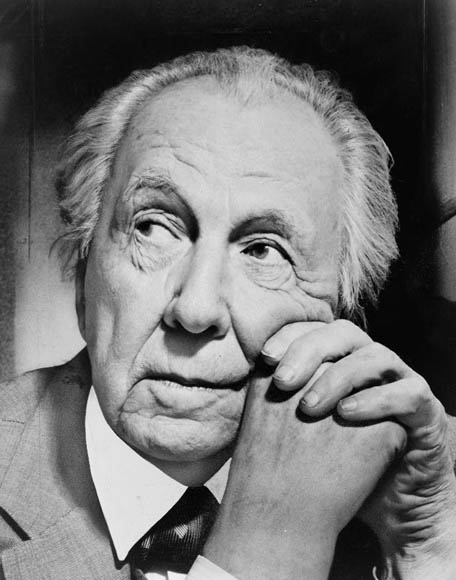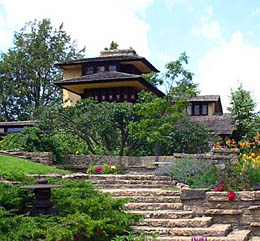
The buildings of F. L. Wright often "spilled" into nature
 |
The architect was professionally active until a very old age. He designed his key work, the spirally twisted barrier-free building for the Solomon Guggenheim collection, when he was nearing eighty. The building subsequently ranked alongside the exhibits it was meant to protect - works by Picasso, Chagall, Pollock, or Kandinsky. The Museum of Modern Art opened in 1959 and still appears very avant-garde today. However, its author did not enjoy the fame, as he died half a year before its completion.
 |
However, the personal life of the successful Wright was very dramatic. He left his wife Catherine and six children and went to Europe with Mamah Cheney. Tragically, she died in 1914 with her two children and four of Wright's associates in a fire at Taliesin, his estate in Wisconsin (Wright later married twice more and had another daughter). Europe admired him, but his career in the USA lay in ruins. Nevertheless, Wright mobilized his strength and focused on rebuilding the house.
The land of the rising sun was always a great comfort and inspiration to him, where he built the Imperial Hotel in Tokyo between 1916 and 1922. Wright, who combined tradition with modernity and new technologies, once again went into great detail - he designed the interior furnishings, including tea and coffee sets. The fact that the hotel was one of the few buildings to survive the great earthquake in 1923 without damage contributed to Wright's international fame. Unfortunately, the successful building no longer exists today.
 |
Wright's credit was confirmed by the administrative building of S. C. Johnson & Son Co. on slender "tree-like" columns. After World War II, he designed about 350 buildings over 15 years. Some were completed only after his death, others remained merely on paper, such as the design for The Mile High Illinois Skyscraper, a one-and-a-half-kilometer-high skyscraper for 100,000 people with atom-powered elevators.
Wright was born on June 8, 1867, in Wisconsin. After brief studies at the local university and episodes in studios, he joined the team of Louis H. Sullivan, a leading figure of the Chicago School. He stayed there until 1893 when he became independent. Wright's Robie House in Chicago is considered by experts, alongside the Tugendhat Villa by Mies van der Rohe in Brno, Adolf Loos's Steiner Villa in Vienna, and Le Corbusier's Savoy Villa in Poissy, to be one of the key buildings of modern architecture.
The work of the American designer has influenced the Czech scene since the 1920s. Wright's traces can be found in some buildings by Jan Kotěra, Bohuslav Fuchs, or Jaroslav Fragner. Some Czechs also collaborated with Wright, such as engineer and construction entrepreneur Jaroslav Polívka or architect Vladimír Karfík. In 2001, an exhibition was held in Prague that presented the work of the famous architect for the very first time in a comprehensive manner.
The English translation is powered by AI tool. Switch to Czech to view the original text source.
0 comments
add comment






